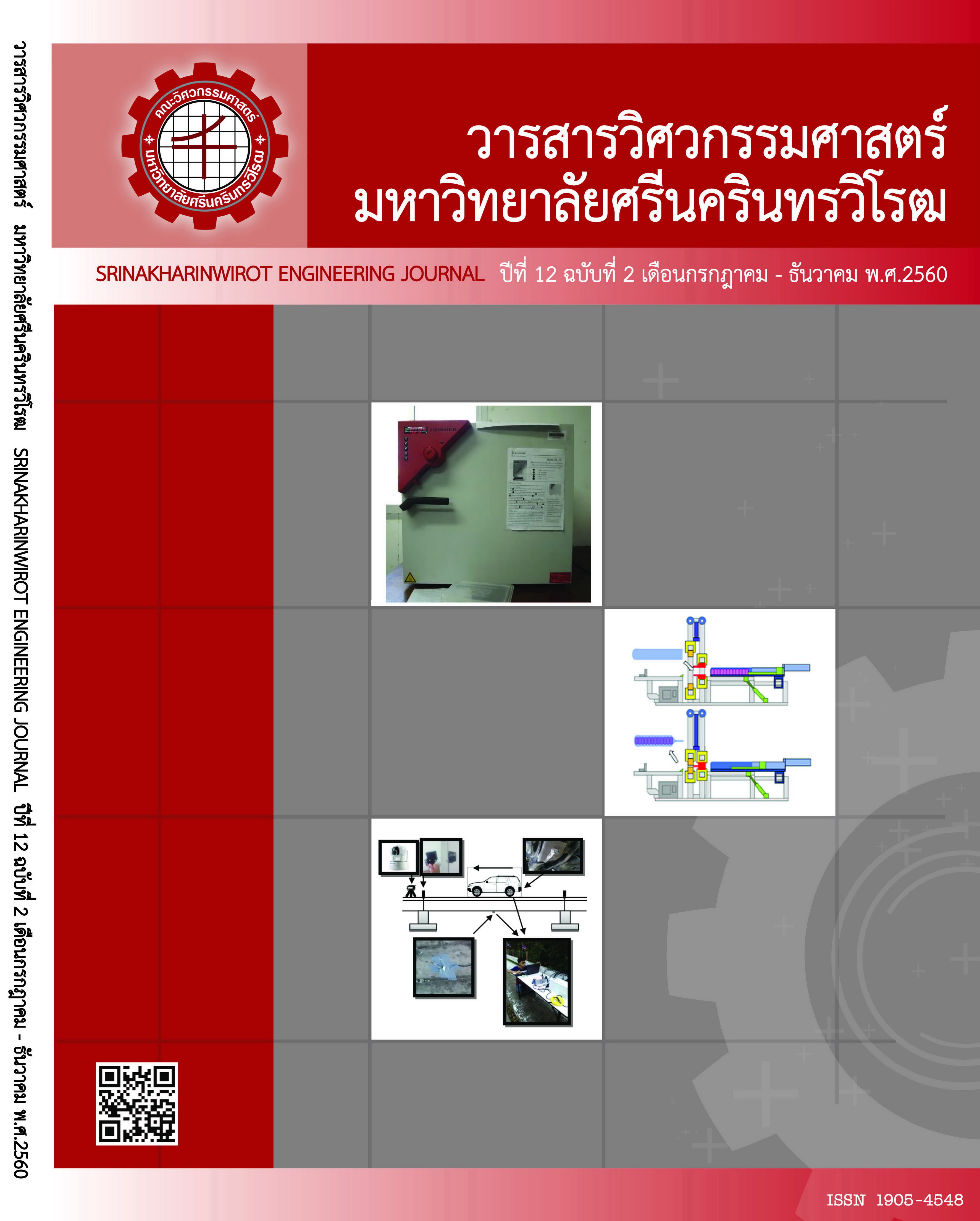DEVELOPMENT OF FRAME ELEMENT FOR NONLINEAR FINITE ELEMENT ANALYSIS OF REINFORCED CONCRETE SHEAR WALLS CONSIDERING SHEAR DEFORMATION
Main Article Content
Abstract
This paper presents analytical procedures of the flexibility-based for the nonlinear analysis of frame elements with shear deformation developed to model the behavior of RC shear walls which can fail suddenly at lower ductility levels. An analytical procedure was developed for plasticity sectional response analysis modeling based on smeared crack approaches by section discretization into layers. The plasticity sectional analyses were made to capture shear mechanisms in a section of concrete, with the inclusion of nonlinear Poisson effects, softening effect of concrete, tension stiffening, as well as confining effects for out-of-plane steel reinforcement and especially with dowel action. Based on flexibility method, element forces were obtained by performing equilibrium-based numerical integration on section behaviors along the length of the elements. Verification of the accuracy of the procedure was undertaken with six specimens. A good fit between experimental and theoretical results provided by the model was obtained.
Article Details
Copyright belongs to Srinakharinwirot University Engineering Journal
References
[2] Li, YR. and Jirsa, JO., “Nonlinear analysis of an instrumented structure damaged in the 1994 Northridge earthquake” Earthquake Spectra., vol. 14(2), pp. 265-283, 1998.
[3] Elwood, K., “Modeling failures in existing reinforced concrete columns,” Canadian Journal of Civil Engineering., vol. 31(5), pp. 846-859, 2004.
[4] Lee, DH., Elnashai, A. “Seismic analysis of RC bridge columns with flexure-shear interaction,” Journal of Structural Engineering, ASCE., vol. 127(5), pp. 546-553, 2001.
[5] Lee, DH., Elnashai, A., “Inelastic seismic analysis of RC bridge piers including flexure- shear-axial interaction,” Structural Engineering and Mechanics., vol. 13(3), pp. 546-553, 2002.
[6] Xu, SY., Zhang, J., “Axial-shear-flexure interaction hysteretic model for RC columns under combined actions,” Journal of Engineering Structures., vol. 34(1), pp. 548-563, 2012.
[7] Spacone, E., Filippou, FC., Taucer, FF., “Fiber beam-column model for nonlinear analysis of R/C frames, part I: formulation,” Earthquake Engineering and Structural Dynamics., vol. 25, pp. 711-725, 1996.
[8] Ranzo, G., Petrangeli, M.A., “Fiber finite beam element with section shear modeling for seismic analysis of RC structures,” Journal of Earthquake Engineering., vol. 2(3), pp. 443-473, 1998.
[9] Shirai, N., Moriizumi, K., Terasawa K., “Cyclic analysis of reinforced concrete columns macro-element approach, modeling of inelastic behavior of RC structures under seismic load,” Reston, Virginia: American Society of Civil Engineers., 2001, pp. 435-453.
[10] Marini, A., Spacone, E., Analysis of reinforced concrete elements including shear effects. Structural Journal, American Concrete Institute., vol. 103(5), 645-655, 2006.
[11] Petrangeli, M., Pinto, PE., Ciampi, V., “Fiber element for cyclic bending and shear of R/C structures, part I: theory,” Journal of Engineering Mechanics, ASCE., vol. 125(9), pp. 994-1001, 1999.
[12] Vecchio, F.J. & Collins, M.P, “Stress–Strain Characteristic of Reinforced Concrete in Pure Shear,” IABSE Colloquium, Advanced Mechanics of Reinforced Concrete, Delft, Final Report, International Association of Bridge and Structural Engineering, Zurich, Switzerland., 1981, pp. 221–225.
[13] Vecchio, F.J. & Collins, M.P, “The Modified Compression Field Theory for Reinforced Concrete Elements Subjected to Shear,” ACI JOURNAL., ProceedingsV. vol. 83, No. 2, pp. 219-231, Feb. 1986.
[14] Belarbi, A. & Hsu, T.T.C, “Constitutive Laws of Concrete in Tension and Reinforcing Bars Stiffened by Concrete,” ACI Structural Journal., vol. 91, No. 4, pp. 465-474, 1994.
[15] Pang, X.B. & Hsu, T.T.C, Behavior of Reinforced Concrete Membrane Elements in Shear, ACI Structural Journal., vol. 92(6), pp 665–679, 1995.
[16] Belarbi, A. & Hsu, T.T.C, “Constitutive Laws of Concrete in Tension and Reinforcing Bars Stiffened by Concrete,” ACI Structural Journal., vol. 91, No. 4, pp. 465-474, July-Aug. 1994.
[17] Hsu, T.T.C. & Zhang, L.X, “Nonlinear Analysis of Membrane Elements Fixed-Angle Softened Truss Model,” ACI Structural Journal., vol. 94, No. 5, pp. 483-492, Sept.-Oct. 1997.
[18] Zhang, L.X. & Hsu, T.T.C, “Behavior and Analysis of 100Mpa Concrete Membrane Elements,” Journal of Structural Engineering, ASCE., vol. 124, No. 1, pp. 24-34, Jan. 1998.
[19] Zhu, R.H.; Hsu, T.T.C.; and Lee, J. Y, “Rational Shear Modulus for Smeared Crack Analysis of Reinforced Concrete,” ACI Structural Journal., vol. 98, No. 4, pp. 443-450. 2001.
[20] Zhu, R.H. & Hsu, T.T.C, “Poisson Effect of Reinforced Concrete Membrane Elements,” ACI Structural Journal., vol. 99, No. 5, pp. 631-640, Sept.-Oct. 2002.
[21] Spacone, E.; V. Ciampi.; F.C. Filippou, “MIXED FORMULATION OF NONLINEAR BEAM FINITE ELEMENT,” Computers & Stuctures., vol. 58, No.1, pp. 71-83, 1996.
[22] Kupfer, HB.; Hildorf, HK.; Rusch, H, “Behavior of concrete under biaxial stresses,” Structural Journal of the American Concrete Institute., vol. 66(8), pp. 656–66, 1969.
[23] Vecchio, F. J, “Disturbed Stress Field Model for Reinforced Concrete: Formulation,” Journal of Structural Engineering., vol. 12, No.69, pp. 1070-1077, 2000.
[24] Vecchio,F.J, “Finite Element Modeling of Concrete Expansion and Confinement,” Journal of Structural Engineering, ASCE., vol. 118, No. 9. pp. 2390-2405, 1992.
[25] He, X.G. and Kwan, A.K.H, “Modeling Dowel Action of Reinforcement Bars for Finite Element Analysis of Concrete Structures,” Computers and Structures., vol. 79, No.6, pp. 595-604, 2001.
[26] Lefas, I. D., Kotsovos, M. D. and Ambraseys, N. N, “Behaviour of Reinforced Concrete Structural Walls: Strength, Deformation Characteristics and Failure Mechanism,” ACI Structural Journal., vol. 87, No.1, pp. 23-31, January-February 1990.
[27] Collins,M.P. and Mitchell, D, “Prestressed Concrete Structures,” Prentice-Hall, 1991, pp. 345.


